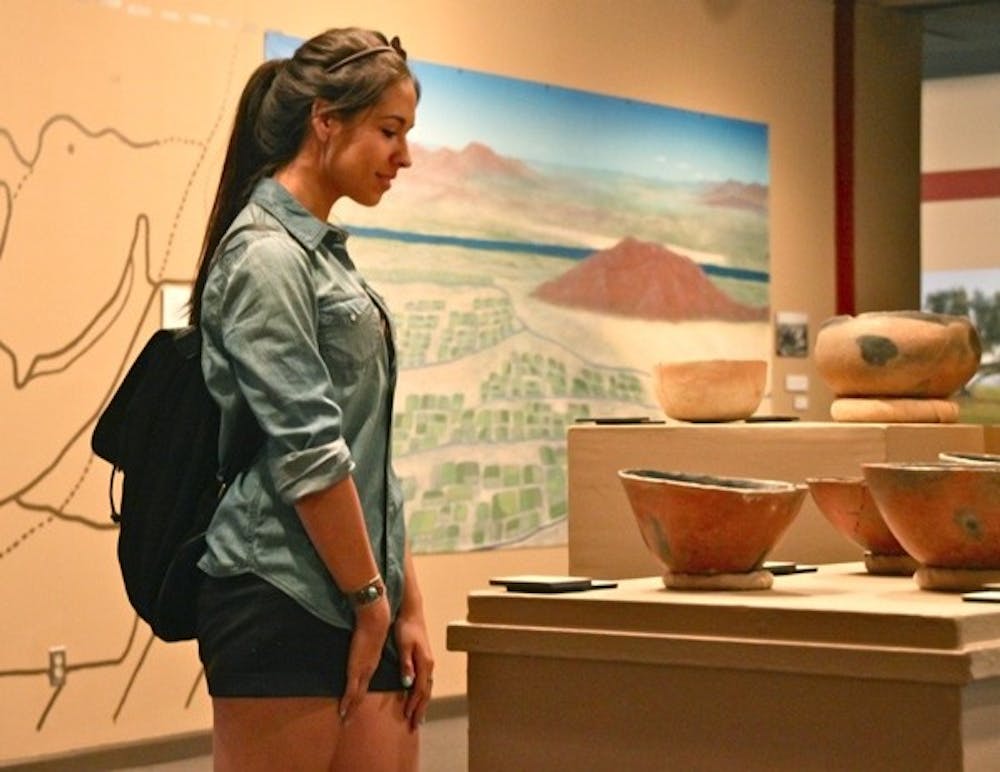Some say to know your future, you must know your past.
A new water exhibit at the ASU Museum of Anthropology hopes to use history to start a community conversation by comparing and contrasting modern-day water dilemmas with that of the Hohokam, a prehistoric Southwest Indian group that lived in the Phoenix basin.
Judy Newland, director of the museum, said the exhibit was put together over six months and was based on a research paper by faculty members in ASU’s School of Human Evolution and Social Change. It is the first time an exhibit theme has been taken directly from faculty research.
Graduate students in ASU’s Museum Studies program and Exhibition Design class then worked together to create the framework and installation for the exhibit. It was opened in collaboration with an international science and policy conference held on the Tempe campus last month called Resilience 2011.
Ric Alling, a master’s student in museum studies, researched and painted a mural depicting an archaeological perspective of prehistoric Hohokam canals, historic canals and contemporary canals.
“People will tell you this [canal system] was comparable to the pyramids,” Alling said.
The canal systems show the Hohokam had a complex social structure and hierarchy to be able to plan the construction and get enough material, he said.
The exhibit contains historical artifacts, photographs and paintings of Southwest agriculture, plants and infrastructure to illustrate the kind of environment the Hohokam lived in and how they interacted with it.
Some of the pieces in the exhibit are much closer to home for ASU students than they think.
“One of the pots was found by the Noble Library, so basically we’re saying we’re living on top of a civilization,” Newland said.
There are also interactive games and activities for a hands-on lesson about the trade-offs a society is forced to make between water, energy conservation and development.
One of the activities called “Strike a Balance” has a scale, challenging visitors to balance out weighted game pieces that represent different amounts of water supply and people.
J. Marty Anderies, an associate professor in the School of Human Evolution and Social Change, was part of the faculty research team behind the exhibit and studied how individual decision-making processes influence social and physical environments, including the Hohokam area.
“The reason that this whole exhibit is motivated by modern concepts using an archaeological context is because resilience and vulnerability are intimately related,” he said.
Anderies said that when seeking to become resilient to some uncertainties, you will necessarily become vulnerable to others. This is why it was important for the Hohokam to focus on social interactions, trade network and irrigation systems to survive.
Today, he said Southwest inhabitants have reservoirs and watersheds like the Colorado River Basin to store water, but there are other states competing for that same water with Arizona, creating tension.
The exhibit doesn’t just want to show that the Hohokam did well, Newland said, but rather “it’s the fact that they did well for so long. One thousand years they did things right.”
She also said the idea that the Hohokam disappeared is actually a myth. Instead it was a more gradual process.
Since its opening on March 7, Peter Banko, the museum outreach and operations coordinator, said the exhibit has had around 15 to 16 student groups visit as well as high school student orientation tours.
The ASU Museum of Anthropology is located on the Tempe campus in the School of Human Evolution and Social Change Building. Admission is free to the museum, which is open Monday to Friday from 11 a.m. to 3 p.m.
The exhibit runs until April 15, but Newland hopes visitors will think about the trade-offs between providing for our present needs and saving for future ones.
“We need to look into the future a thousand years, not a hundred,” she said.
Reach the reporter at naberra@asu.edu





